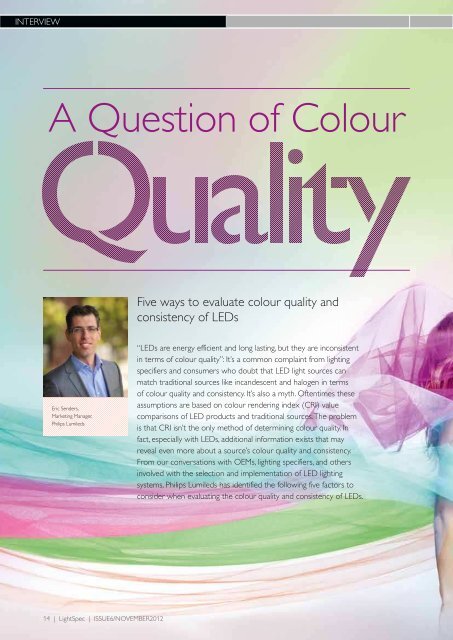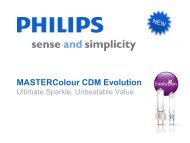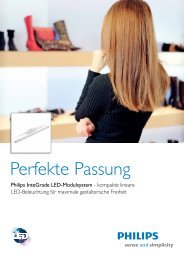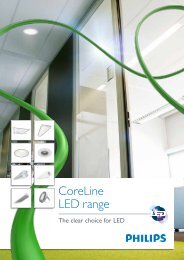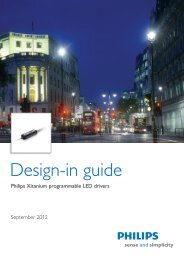Quality of light and the - Philips Lighting
Quality of light and the - Philips Lighting
Quality of light and the - Philips Lighting
Create successful ePaper yourself
Turn your PDF publications into a flip-book with our unique Google optimized e-Paper software.
iNtERViEW<br />
a Question <strong>of</strong> Colour<br />
Eric senders,<br />
Marketing Manager,<br />
<strong>Philips</strong> Lumileds<br />
Five ways to evaluate colour quality <strong>and</strong><br />
consistency <strong>of</strong> LEDs<br />
“LEDs are energy efficient <strong>and</strong> long lasting, but <strong>the</strong>y are inconsistent<br />
in terms <strong>of</strong> colour quality”: it’s a common complaint from <strong>light</strong>ing<br />
specifiers <strong>and</strong> consumers who doubt that LED <strong>light</strong> sources can<br />
match traditional sources like inc<strong>and</strong>escent <strong>and</strong> halogen in terms<br />
<strong>of</strong> colour quality <strong>and</strong> consistency. it’s also a myth. <strong>of</strong>tentimes <strong>the</strong>se<br />
assumptions are based on colour rendering index (CRi) value<br />
comparisons <strong>of</strong> LED products <strong>and</strong> traditional sources. <strong>the</strong> problem<br />
is that CRi isn’t <strong>the</strong> only method <strong>of</strong> determining colour quality. in<br />
fact, especially with LEDs, additional information exists that may<br />
reveal even more about a source’s colour quality <strong>and</strong> consistency.<br />
From our conversations with oEMs, <strong>light</strong>ing specifiers, <strong>and</strong> o<strong>the</strong>rs<br />
involved with <strong>the</strong> selection <strong>and</strong> implementation <strong>of</strong> LED <strong>light</strong>ing<br />
systems, <strong>Philips</strong> Lumileds has identified <strong>the</strong> following five factors to<br />
consider when evaluating <strong>the</strong> colour quality <strong>and</strong> consistency <strong>of</strong> LEDs.<br />
// 1. Colour Rendering<br />
Colour rendering is about how accurately<br />
<strong>the</strong> different colors <strong>of</strong> an object show up<br />
under <strong>light</strong>. to ensure a good quality <strong>of</strong> <strong>light</strong>,<br />
<strong>light</strong>ing designers are dem<strong>and</strong>ing a CRi that<br />
is greater than 80 for indoor applications. But<br />
CRi isn’t <strong>the</strong> only metric that matters when<br />
determining <strong>the</strong> colour rendering ability <strong>of</strong> an<br />
LED <strong>light</strong> source. Colour rendering also consists<br />
<strong>of</strong> different Rvalues, where certain Rvalues<br />
represent a certain colour. <strong>the</strong> right Rvalue will<br />
be determined by <strong>the</strong> application. For instance,<br />
in Retail settings a high R9 value is important<br />
because it is <strong>the</strong> red index that will help to<br />
render <strong>the</strong> vivid red colour that is present in<br />
most Retail objects. From a colour rendering<br />
perspective, <strong>Philips</strong> Lumileds <strong>of</strong>fers different<br />
LuXEoN LEDs that deliver <strong>the</strong> right Rvalue<br />
for <strong>the</strong> intended application.<br />
// 2. Colour consistency over temperature<br />
since LEDs have different colors at different<br />
temperatures, <strong>the</strong> colour <strong>of</strong> an LED depends<br />
on <strong>the</strong> junction temperature <strong>of</strong> its system.<br />
this is important to consider when evaluating<br />
LED <strong>light</strong> sources since many LED manufacturers<br />
list a 25 o C operating temperate on <strong>the</strong>ir data<br />
sheets, while real application temperatures<br />
<strong>of</strong>ten are around 85 o C. also, LED products<br />
from different manufacturers may shift colour<br />
in different directions. <strong>the</strong> good news is that<br />
some leading LED manufacturers, including<br />
<strong>Philips</strong> Lumileds, now specify <strong>the</strong>ir LEDs at real<br />
application temperatures (85 o C), so that <strong>the</strong><br />
colour customers order is <strong>the</strong> exact colour that<br />
<strong>the</strong>y receive.<br />
// 3. Colour consistency between LEDs<br />
Binning is a huge topic <strong>of</strong> discussion surrounding<br />
LEDs. <strong>and</strong> for good reason. it’s not uncommon<br />
for a specifier to select<br />
LED products that are<br />
seemingly from <strong>the</strong> same<br />
bin, only to find significant<br />
visible differences<br />
between those products<br />
after <strong>the</strong>y are installed.<br />
to help end such mishaps,<br />
aNsi introduced new<br />
st<strong>and</strong>ards in 2008<br />
that m<strong>and</strong>ate LED<br />
manufacturers to bin <strong>the</strong>ir LEDs according to a<br />
7step Macadam ellipse. (<strong>the</strong> smallest ellipse is<br />
a 1step ellipse, which will give <strong>the</strong> best colour<br />
consistency.) While ensuring that bins fall within<br />
7 steps <strong>of</strong> this center point was a good first step<br />
towards eliminating colour inconsistency, <strong>the</strong>re<br />
is still additional work to be done. according<br />
“CRI isn’t <strong>the</strong> only<br />
metric that matters<br />
when determining <strong>the</strong><br />
colour rendering ability<br />
<strong>of</strong> an LED <strong>light</strong> source.”<br />
www.philips.com/<strong>light</strong>spec<br />
to Macadam’s research, people may detect a<br />
difference in colour between two sources if<br />
<strong>the</strong>y are far<strong>the</strong>r apart than a 3step Macadam<br />
ellipse. <strong>Philips</strong> Lumileds was <strong>the</strong> first one to<br />
implement products that completely fall within<br />
a single 3step Macadam ellipse. Even now,<br />
LED manufacturers are continuously improving<br />
<strong>the</strong> phosphor technologies to achieve a tighter<br />
distribution <strong>of</strong> LEDs in <strong>the</strong> production process.<br />
// 4. Colour consistency in <strong>the</strong> beam<br />
When designing an LED system, it is important<br />
that <strong>the</strong> final system design has a uniform colour<br />
in <strong>the</strong> beam. <strong>the</strong> down<strong>light</strong> with a halo in <strong>the</strong><br />
beam, for instance, is not ideal. While this beam’s<br />
colour consistency can be improved with a good<br />
reflector or secondary lens design, it helps when<br />
<strong>the</strong> LED source is itself consistent.<br />
this will enable customers who work with<br />
individual optics on LEDs to bring products to<br />
market faster <strong>and</strong> without incurring additional<br />
costs associated with cumbersome secondary<br />
lensing. Most LEDs in <strong>the</strong> market have a<br />
difference in colour over angle <strong>of</strong> about 2025<br />
points (delta u’v’). New LED technologies,<br />
however, prove that it is possible to stay within<br />
10 points delta u’v’ difference in <strong>the</strong> beam.<br />
Examples <strong>of</strong> this are <strong>Philips</strong> Lumileds<br />
LuXEoN a <strong>and</strong> LuXEoN s products.<br />
LuXEoN a used in <strong>Philips</strong> Lightolier spot <strong>light</strong>s<br />
to illuminate <strong>the</strong> splendid store in New york.<br />
// 5. Colour consistency over time<br />
Perhaps specifiers’ biggest concern about LEDs is<br />
reliability. Everybody knows a manufacturer that<br />
promises a 50,000hour lifetime for its products,<br />
but <strong>the</strong> larger question is: What does <strong>the</strong> <strong>light</strong><br />
source look like at 50,000 hours? How much<br />
<strong>light</strong> is still produced? <strong>and</strong> have <strong>the</strong> colors shifted<br />
since <strong>the</strong> initial installation?<br />
since most illuminationgrade<br />
LEDs have not<br />
yet been installed for<br />
50 years, it is difficult to<br />
determine this; however,<br />
LED manufacturers have<br />
developed sophisticated<br />
stress models that predict<br />
<strong>the</strong> behavior <strong>of</strong> LEDs<br />
over lifetime. Guidelines<br />
like iEs LM80 or iEs tM21 can help guide LED<br />
manufacturers through <strong>the</strong> process <strong>of</strong> measuring<br />
LED maintenance <strong>and</strong> colour shift over time.<br />
it is essential that manufacturers make <strong>the</strong>ir<br />
test results <strong>and</strong> data publically available, <strong>and</strong> we<br />
suggest that all oEMs proactively ask for <strong>the</strong>se<br />
data from <strong>the</strong>ir LED manufacturers.<br />
ultimately, if oEMs take <strong>the</strong>se five main tenets <strong>of</strong> quality <strong>of</strong> <strong>light</strong> into consideration, we believe that it<br />
will improve LED colour quality <strong>and</strong> increase <strong>the</strong> adoption <strong>of</strong> this great new technology.<br />
14 | Lightspec | issuE6/NoVEMBER2012 issuE6/NoVEMBER2012 | Lightspec | 15


